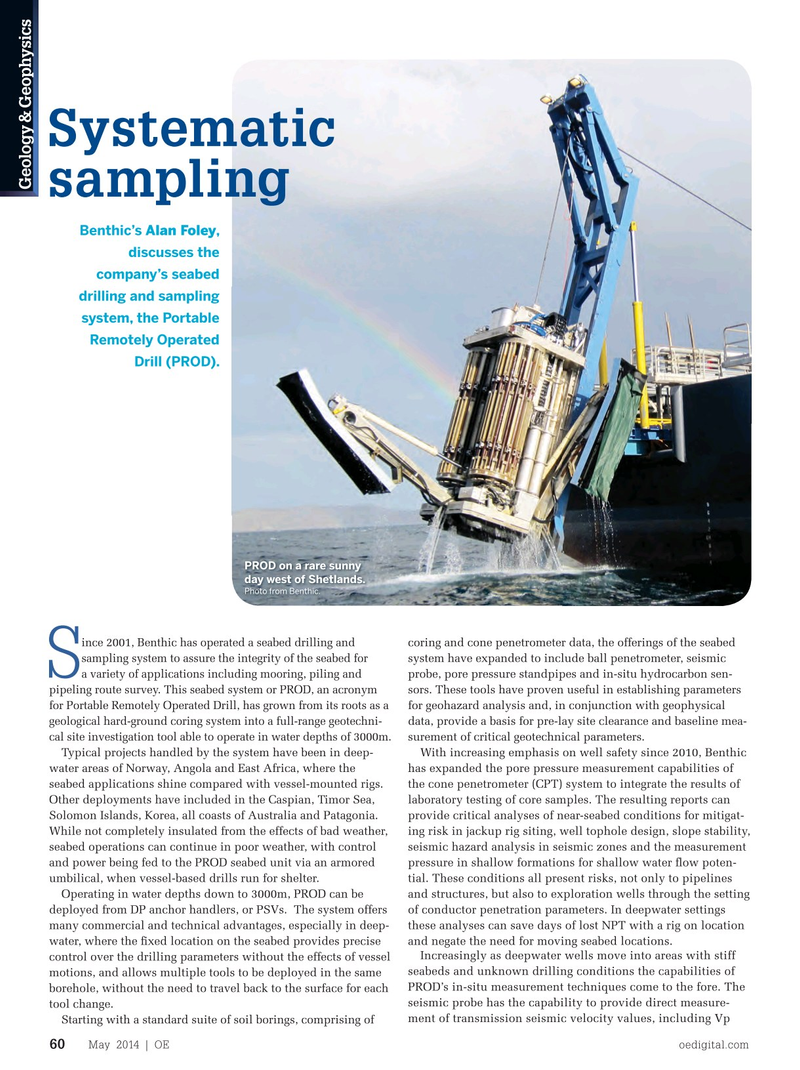
Page 58: of Offshore Engineer Magazine (May/Jun 2014)
Read this page in Pdf, Flash or Html5 edition of May/Jun 2014 Offshore Engineer Magazine
Systematic
Geology & Geophysics sampling
Benthic’s Alan Foley, discusses the company’s seabed drilling and sampling system, the Portable
Remotely Operated
Drill (PROD).
PROD on a rare sunny day west of Shetlands.
Photo from Benthic. ince 2001, Benthic has operated a seabed drilling and coring and cone penetrometer data, the offerings of the seabed sampling system to assure the integrity of the seabed for system have expanded to include ball penetrometer, seismic
S a variety of applications including mooring, piling and probe, pore pressure standpipes and in-situ hydrocarbon sen- pipeling route survey. This seabed system or PROD, an acronym sors. These tools have proven useful in establishing parameters for Portable Remotely Operated Drill, has grown from its roots as a for geohazard analysis and, in conjunction with geophysical geological hard-ground coring system into a full-range geotechni- data, provide a basis for pre-lay site clearance and baseline mea- cal site investigation tool able to operate in water depths of 3000m. surement of critical geotechnical parameters.
Typical projects handled by the system have been in deep- With increasing emphasis on well safety since 2010, Benthic water areas of Norway, Angola and East Africa, where the has expanded the pore pressure measurement capabilities of seabed applications shine compared with vessel-mounted rigs. the cone penetrometer (CPT) system to integrate the results of
Other deployments have included in the Caspian, Timor Sea, laboratory testing of core samples. The resulting reports can
Solomon Islands, Korea, all coasts of Australia and Patagonia. provide critical analyses of near-seabed conditions for mitigat-
While not completely insulated from the effects of bad weather, ing risk in jackup rig siting, well tophole design, slope stability, seabed operations can continue in poor weather, with control seismic hazard analysis in seismic zones and the measurement and power being fed to the PROD seabed unit via an armored pressure in shallow formations for shallow water ? ow poten- umbilical, when vessel-based drills run for shelter. tial. These conditions all present risks, not only to pipelines
Operating in water depths down to 3000m, PROD can be and structures, but also to exploration wells through the setting deployed from DP anchor handlers, or PSVs. The system offers of conductor penetration parameters. In deepwater settings many commercial and technical advantages, especially in deep- these analyses can save days of lost NPT with a rig on location water, where the ? xed location on the seabed provides precise and negate the need for moving seabed locations.
Increasingly as deepwater wells move into areas with stiff control over the drilling parameters without the effects of vessel seabeds and unknown drilling conditions the capabilities of motions, and allows multiple tools to be deployed in the same
PROD’s in-situ measurement techniques come to the fore. The borehole, without the need to travel back to the surface for each seismic probe has the capability to provide direct measure- tool change.
ment of transmission seismic velocity values, including Vp
Starting with a standard suite of soil borings, comprising of
May 2014 | OE oedigital.com 60 060_0514OE_G&G_Benthic.indd 60 4/18/14 7:37 PM

 57
57

 59
59